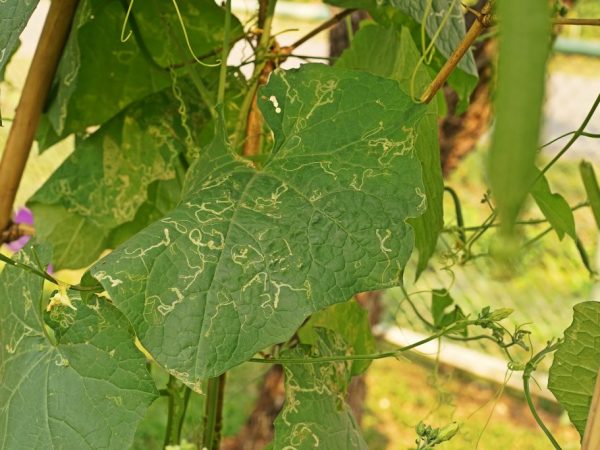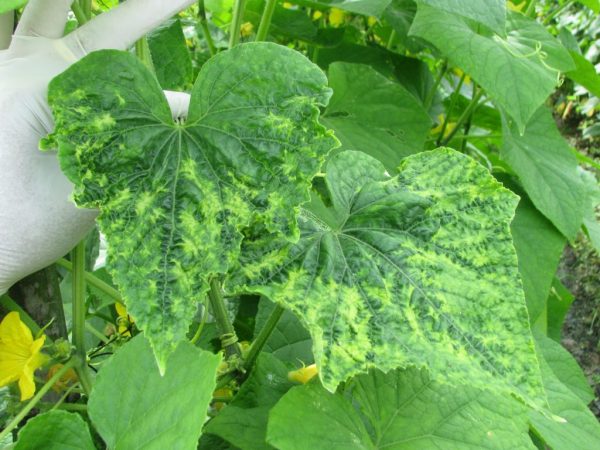Why do cucumber leaves become marbled
The condition of the leaves is one of the indicators of the health of a cucumber plant. Marble leaves in cucumbers signal the onset of a viral disease or a lack of a nutrient - magnesium. These two problems have effective solutions. The main thing is to identify the cause of the marbling of the leaf in time.

The cause of marble leaves in cucumbers
Lack of magnesium
Cucumbers are one of the most demanding plants for the mineral composition of the soil. Throughout the entire growing period, the cucumber bush needs to receive in sufficient quantities not only water and sunlight, but also micro and macro elements.
Cucumbers, like other vegetables, absorb nutrients in an amount that meets their needs. If the plant is under stress (temperature, chemical, water), a lack of them may appear.
Marble leaves of cucumbers with alternating light green and dark green spots or have a solid color. This indicates a lack of magnesium in the leaves of the plant.
The role of magnesium in plants
Magnesium is one of the chemical constituents of chlorophyll (green pigment). He also:
- accompanies the process of photosynthesis and the formation of chlorophyll;
- participates in the transport of phosphates in the plant;
- regulates the absorption of nutrients and water through the roots of the plant.
This element is needed by the plant throughout the entire growing time.
Magnesium starvation first of all affects old vines and develops from the bottom up. The cucumber bush stops growing.
Reasons for a lack of magnesium
Signs of magnesium deficiency appear when the cucumber is heavily weighted with fruits and during the beginning of their ripening. The consumption of this element by the plant is very active, but in the case of feeding in large doses, assimilation is slow.
Magnesium deficiency can also arise from oversaturation with potassium. This problem often occurs on acidic soil in greenhouses.
To solve the problem of magnesium deficiency, before planting, the soil is treated with dolomite flour. She is an excellent supplier of this important element.
Mosaic

The virus can infect all plants
Marble coloring of plant umbrellas in yellow-green tones is a mosaic disease. This viral infection strikes plants in greenhouses with lightning speed, develops rapidly with temperature changes and dense plantings.
- In young seedlings, it is difficult to detect signs of disease during the first few weeks. Symptoms may begin to appear when plant growth is enhanced.
- This virus spreads outdoors and in greenhouses with the help of garden insects (spider mites, aphids), and also hibernates in organic debris.
- The cucumber mosaic virus spreads with infected seeds, in which it can remain for a long time. The indicator decreases only after 2-3 years.
It can also be transferred to cucumbers from garden appliances, which were used to process carriers of the virus - garden flowers: cannes, gladioli, phlox. Tool disinfection is one of the main ways to prevent infection.
Varieties of mosaics
To date, several varieties of the viral mosaic of the cucumber are known.
Ordinary mosaic
This virus infects cucumbers, especially those grown in greenhouses. It manifests itself in the defeat of young leaves of seedlings. They are dotted with spots with dark green and light green parts. The edges of the umbrellas are folded down. Sometimes the stem cracks at the base.
English mosaic
Green mosaic, or English mosaic of cucumbers, is also a parasite in greenhouses. The disease occurs equally frequently in adults and young plants. Bushes affected by the virus slow down growth, light streaks appear on the leaves. Cucumbers become deformed, their taste becomes bitter. The seeds in the fruit look underdeveloped.
White mosaic
White mosaic often affects the plant along with green mosaics. First of all, blurry light yellow spots appear next to the veins. They resemble rings or stars in outlines, and then turn greenish-white. As the disease progresses, the spots coalesce and the entire leaf surface turns white or yellow. Ultimately, the leaf dries and falls off.
Tobacco mosaic
Less common of all types of mosaic on cucumbers is tobacco. A mosaic marble pattern and emerald-beige stains appear on the infected leaves. The part of the leaf that remains green swells and becomes bumpy.
Control methods
Cucumber viral diseases are the most dangerous for the crop. They are almost impossible to cure. There is no chemical agent capable of destroying the mosaic. It seems possible only to prevent their mass distribution. This requires:
- If a diseased plant is identified, remove it from the site, even if the disease is in its initial stage. This manipulation helps to protect the rest of the cucumber plants and preserve the harvest.
- Destroy weeds and organic debris. Viruses can fully live not only on fresh weeds, but also on dry plants in the garden. They even winter quietly on these remains. The virus persists in them for up to several decades.
- Timely carry out the fight against aphids and spider mites. When planting, the plants are placed farther from each other, after which they are carefully examined every morning.
- Disinfect working tools. Ethyl alcohol is used for disinfection. but before treating with alcohol, it is better to place the inventory that has come into contact with contaminated soil and plants in boiling water.
- Observe the crop rotation. The soil is also capable of infecting plants that are planted on it in the following year, after diseased bushes. It is necessary to observe crop rotation every year, planting infected areas of the garden with crops that do not succumb to the mosaic virus. In the open field, it is viable for up to 5 years.
- Disinfect seeds before sowing. It is possible to destroy the virus in the seeds by heating dry seeds before sowing to a temperature of 50 ° C for 3 days, and after one day to 70 ° C. You can also purchase a disinfectant chemical from a specialist store.
Conclusion
With a lack of magnesium, the entire crop dies due to the defeat of the viral mosaic. Getting rid of marbling improves the general condition of the plant. It also has a positive effect on yields. Zelentsy become more juicy and crispy.


